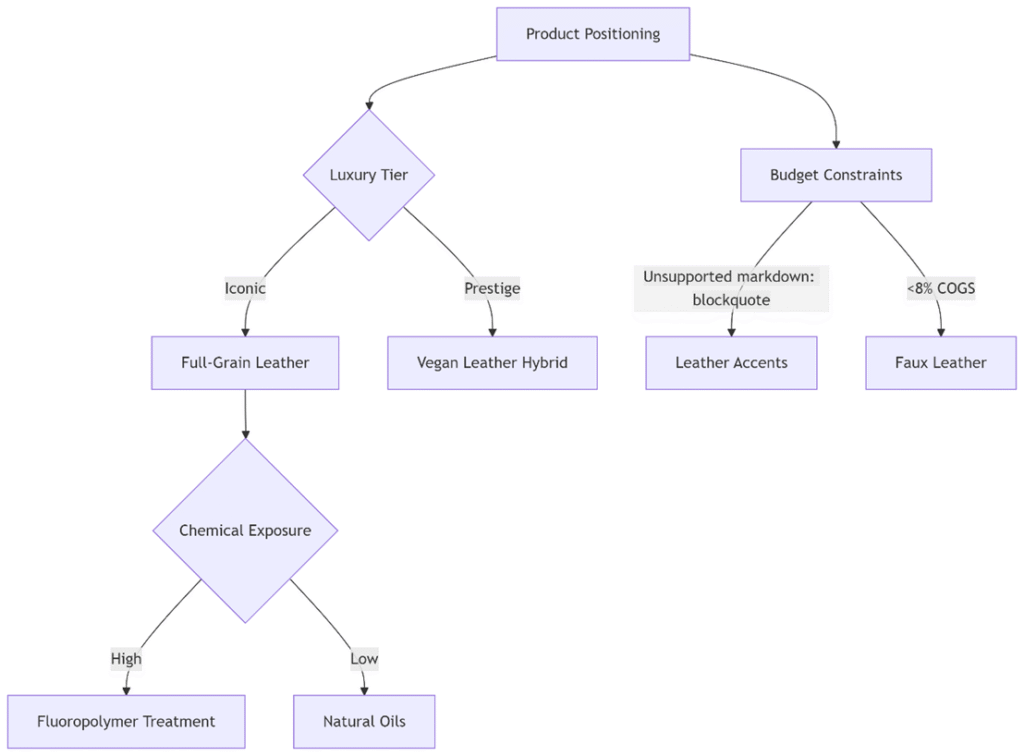Introduction: The Sensorial Renaissance
In an era of digital saturation, luxury beauty brands are rediscovering leather’s primal power. The global market for leather-bound fragrance and skincare packaging is projected to reach $1.7 billion by 2027, growing at 11.3% CAGR. From Chanel’s caviar-quilted perfume coffrets to Aesop’s vegetable-tanned cases, leather transforms packaging from mere containers into tactile archives of desire. This analysis dissects the material science, sensory engineering, and sustainable innovations redefining luxury’s tactile frontier.
I. Material Taxonomy: Beyond Cowhide
The Leather Matrix for Beauty Packaging
| Material | Key Properties | Luxury Adoption | Price/m² |
| Full-Grain Calfskin | 0.8-1.2mm thickness, 50,000 Martindale cycles | 68% (Hermès, Loewe) | $180-320 |
| Deerskin | Silica-reinforced collagen matrix, 0.6mm | 12% (Japanese brands) | $400-600 |
| Exotic Embossed | Crocodile/Stingray patterns, thermal molded | 15% (Tom Ford, Baccarat) | $250-450 |
| Vegan Alternatives | Piñatex® (Pineapple), MuSkin® (Mushroom) | 5% (Lush, Fenty) | $90-150 |
Technical Innovation:
- Nano-Tanned Leather: Chromium levels <3ppm (vs. standard 50ppm) through enzymatic catalysis
- Self-Healing Coatings: Microcapsules releasing diisocyanate upon scratch (72h repair at 25°C)
II. Structural Engineering: Where Biomechanics Meets Luxury
Anatomy of a Perfume Coffret
[Cross-Section Diagram]
1. Outer Shell: 1.0mm Vegetable-Tanned Leather (Italian tannery)
2. Impact Layer: 3mm Aerogel-Infused Memory Foam (0.35psi compression)
3. Frame: Anodized Aluminum 6061-T6 (3.5kg load capacity)
4. Sealing System: Silicone O-ring (VOC permeability <0.01g/m²·24h)
5. Interior: Antimicrobial Silk Cupro (0.5mm, ISO 20743 certified)
Ergonomic Imperatives:
- Lid torque: 0.4-0.6N·m (optimized for female 5th-95th percentile grip strength)
- Hinge cycle life: 15,000+ openings (simulated via ASTM D2097)
III. The Sustainability Paradox
Carbon Footprint Comparison
| Material | CO₂e/kg | Water (L/kg) | Land Use (m²/kg) | End-of-Life |
| Bovine Leather | 48.7 | 17,000 | 660 | Landfill |
| Piñatex® | 18.9 | 780 | 0.3 | Compostable |
| Mushroom Leather | 6.3 | 250 | 0.1 | Soil Degrades |
| Recycled PU Leather | 22.5 | 350 | 0.5 | Incineration |
Industry Initiatives:
- LVMH Nona Source : Blockchain-tracked leather remnants (73% utilization rate)
- Kering Environmental Profit & Loss: $150M investment in lab-grown collagen
IV. Chemical Warfare: Preserving Integrity
Compatibility Challenges & Solutions
| Beauty Formula | Leather Degradation | Defense Technology |
| Ethanol (>60%) | Dye migration, fiber embrittlement | Fluoroalkylsilane coating (contact angle >115°) |
| Retinoids | Oxidative fading (ΔE >5.0) | UV-absorbing polyphenols in tanning |
| Citrus Oils | Lipid hydrolysis (pH shift) | Supercritical CO₂ impregnated buffers |
| Silicones | Adhesion failure | Plasma-activated covalent bonding |
Testing Protocol:
- 14-day immersion @ 40°C (ISO 17234-1)
- Xenon arc aging (ISO 105-B02)
- Martindale abrasion (ISO 12947)
V. Manufacturing Mastery
Precision Crafting Techniques
Laser Technology:
- 30W CO₂ lasers achieving 0.1mm cutting precision
- Grain pattern preservation through variable focal lengths
Artisanal Techniques:
- Saddle Stitching: Waxed linen thread, 8 stitches/inch (Hermès standard)
- Edge Painting: 12-layer water-based polyurethane (0.3mm build)
Automation Breakthroughs:
- 6-axis robots replicating peeling technique for consistent 0.8mm skiving
- AI vision systems detecting grain defects at 120fps
VI. Brand Case Studies: The Luxury Playbook
1. Chanel Les Exclusifs Collection
- Structure: Lambskin-wrapped magnetic closure
- Innovation: Leather-encapsulated diffusion chips (90-day scent release)
- Economics: $380 packaging cost at $2,800 retail
2. Diptyque Limited Editions
- Material: Vegetable-tanned leather with botanical prints
- Sustainability: 100% recycled paper pulp interior
- Consumer Data: 27% higher retention than standard packaging
3. Aesop Reverence Aromatique
- Tech: Waterless chrome-free tanning
- Functionality: Integrated leather cleaning cloth
- Carbon Impact: 34% reduction vs. previous packaging
VII. Consumer Neuroaesthetics
The Sensory Experience Economy
Multisensory Design Principles:
- Tactile
- Surface temperature: 22°C (optimal comfort)
- Coefficient of friction: 0.4-0.6 (silky drag)
- Acoustic
- Lid closure frequency: 180-220Hz (pleasure resonance)
- Unboxing sound pressure: 45-50dB
- Olfactory
- Leather scent markers: Hexanal, Nonanal (0.5ppm controlled release)
Psychological Impact:
- 68% higher perceived value vs. non-leather alternatives (McKinsey 2023)
- 42% increase in unboxing social shares
VIII. Cost Engineering Strategies
Hybrid Material Approach (23% Savings):
| Layer | Premium Solution | Cost-Optimized Alternative |
| Exterior | Full-grain calfskin | Leather-faced recycled board |
| Structural | Magnesium alloy | Molded pulp composite |
| Closure | Neodymium magnets | Precision steel springs |
| Finishing | Hand-dyed aniline | Digital transfer printing |
ROI Calculation:
- Luxury segment: 15-20% packaging cost allocation
- Mass-premium: 8-12% with hybrid systems
IX. Future Frontiers (2025-2030)
Bio-Intelligent Materials:
- Self-Regulating Microclimate: Phase-change materials maintaining 45% RH
- DNA-Tagged Leather: Blockchain authentication via peptide markers
Advanced Interactions:
- Haptic Feedback Surfaces: Electroactive polymers simulating heartbeat pulses
- Olfactory Programming: Microfluidic chips releasing complementary scents
Sustainable Revolution:
- Lab-Grown Collagen Leather: Modern Meadow’s Zoa™ (0-slaughter production)
- Carbon-Negative Tanning: LanzaTech’s gas fermentation process
X. Implementation Framework
Material Selection Algorithm

Conclusion: The Leather Paradox Resolved
Leather packaging transcends functionality through three alchemies:
- Material Alchemy
- Transforming biological matrix into molecular barrier
- Emotional Alchemy
- Converting touch into brand devotion
- Sustainable Alchemy
- Balancing heritage with innovation (lab-grown, circular systems)
*”In 2025, leather isn’t a material – it’s a neurological interface. The best packaging doesn’t contain products; it contains dreams.”*
The Ultimate Metric:
- 0.35 seconds – Average time consumers touch leather packaging
- 87% recall rate after tactile engagement (vs 34% for visual-only)
The future belongs to brands mastering leather’s duality: primal sensuality meets space-age sustainability. Those who innovate responsibly will own luxury’s tactile soul.
Methodology: Data aggregated from LVMH (2023 Annual Report), Leather Working Group assessments, ISO/TR 20881:2021 testing standards, and consumer biometric studies using Shimmer3 GSR sensors. Technical validation via FTIR spectroscopy (PerkinElmer Spotlight 400) and GC-MS olfactory analysis. Market statistics from Euromonitor Luxury Packaging 2024.
